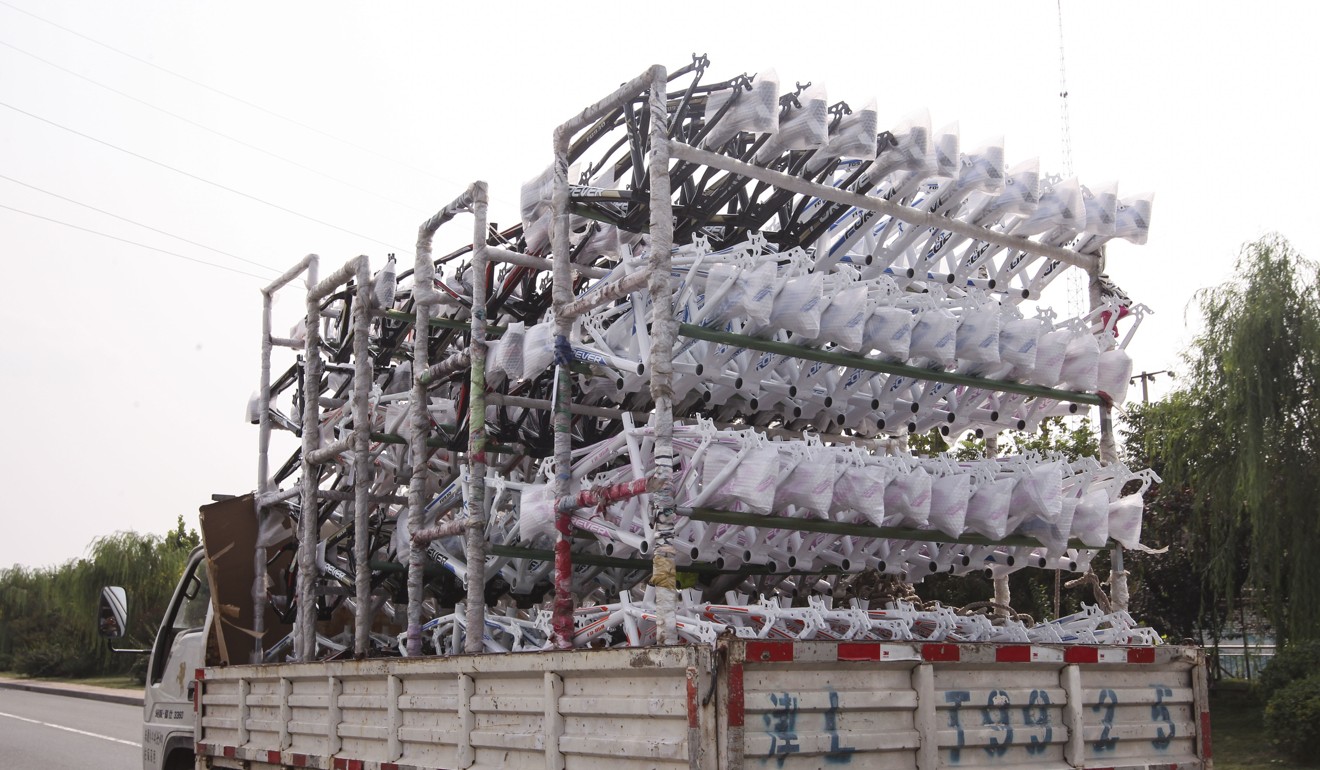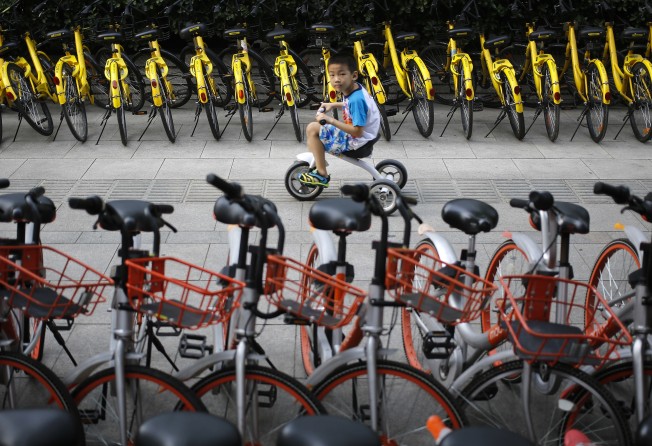
As China’s bike-sharing economy booms, its manufacturers suffer
The wheels have come off for many manufacturers in Wangqingtuo as consumers embrace the rapidly expanding shared economy

At 2pm on a Tuesday, Baochi Bike sales manager Xiao Xizheng was having a nap in her dimly lit shop. Dozens of bikes from the company’s extensive range were lined up in the showroom along the main street in Wangqingtuo, in Tianjin’s western suburbs.
The area used to be the hub of bicycle manufacturing for northern China and even up until a couple of years ago, the streets were crammed with buyers who could not load the stock onto trucks quickly enough for sale around the nation.
But Xiao doesn’t bother turning on the showroom lights these days – hardly anybody comes through the door.
The bike-sharing boom has changed everything. While sharing firms have placed big orders with some manufacturers, others like Baochi have been left out of the race, their prospects punctured by a sharp change in the market.
China has embraced the sharing economy like few other countries, with flourishing platforms offering everything from peer-to-peer lending to rental umbrellas. Chinese consumers lead the world in their in preference for shared products or services, according to a 2014 Nielsen survey. And support for the sector has been written into the country’s 2016-2020 economic blueprint in the hope that the growth will help counter slowing expansion elsewhere.
Bike-sharing firms began taking off around the country early last year, offering internet-connected users a convenient and cheap form of transport around China’s clogged cities with just the swipe of a phone. Backed by more than US$1 billion in combined financing, 70-plus bike-sharing companies entered the rapidly expanding market.
Today, the distinctive silver-and-orange, bumblebee yellow or kingfisher blue shared bikes are clearly visible more than 100 Chinese cities, with possibility of more growth to come.
iiMedia Research, a Guangzhou-based consulting firm, estimated that China’s shared-bike market would expand by 736 per cent to 10.28 billion yuan (US$1.58 billion) this year, and the number of users rise 646 per cent to 200 million.
Tsinghua University economist Yuan Gangming said shared bikes had become a mark of an internet-connected urban lifestyle.
“Nowadays, people who do not use shared bikes are regarded as old-fashioned and looked down on by young people,” Yuan said.
The meet the demand, bike-share firms placed big orders with traditional manufacturers to supply the millions of bikes they needed. Producers responded quickly and increased capacity sharply, leaving others behind.

Felix Tran, an equity strategist with Bank of America Merrill Lynch, said this could be a turning point for those that could not keep up.
“The sharing economy will eventually disrupt most sectors,” Tran said. “An increasing number of companies will potentially fall victim to the creative destruction of a ‘Kodak moment’,” he said, referring to the US photographic film giant’s failure to adapt to digital photography.
Xiao, in Wangqingtuo, is feeling the effects of this disruption first-hand – Baochi’s sales are down by roughly half already this year.
“These bikes were popular just a few years ago,” she said. “But nowadays, riding a shared bike is in vogue. Few buy our bikes even though they are two-thirds of the price they were years ago.”
There are nearly 300 bike plants in the area and for decades the industry was Wangqingtou’s lifeblood, supporting around 40,000 people and accounting for three-quarters of gross domestic product. Wangqingtou produced 13 million bikes in 2015, nearly one-sixth of China’s annual output that year.
But a weekday stroll around the now quiet town suggests an industry in decline, with few buyers in any of the dozens of bike shops.
“Other non-suppliers of shared bikes in our town have similar sales declines,” Xiao said.

However, even the few manufacturers selling to bike-share firms are facing an uncertain future.
“Suppliers of shared bikes are having difficult days as well,” the Baochi sales manager said.
A small number of makers were chosen by bike-sharing platform companies last year to be original equipment manufacturers. After ramping up capacity to fill orders for the sharing platforms, many plants had to stop some production lines or suspend operations altogether, a Tianjin official said.
The official said the downturn was driven by three main factors: the collapse of at least three sharing platforms since June; defaults on payments by share firms as competition and municipal curbs ate into the corporate bottom line; and stricter enforcement of environmental rules on manufacturers.
Wang Huie, an analyst with Beijing-based consulting firm Analysys, said the bike-sharing market was entering a new phase.
“In the first half of the expansion game, platforms brought a huge cake to bike makers in their pursuit of a bigger market share. In the second half, demand will be stable and ... shared bikes will crowd out demand for makers’ brand bikes,” Wang said.

“Bike makers already rely heavily on orders from sharing platforms. If the bike-sharing bubble bursts, the bike industry will be exposed to serious overcapacity.”
China’s capacity for shared bike production has already reached 30 million, while China made 25 million bikes for the domestic market annually before the boom of bike sharing, industry figures show.
“Only those actively change themselves, upgrade and overturn traditional business model will survive,” Wang said.
Tsinghua’s Yang agreed. “Manufacturers involved in the sharing schemes will benefit from the higher technology requirements which are tailored for bike sharing, and those left out will die sooner or later,” he said.
It’s message not lost on Peng Wei, vice-president of Tianjin Aima Technology, a manufacturer about 50km from Wangqingtuo in Tianjin’s Jinghai district.
Peng said Aima was “restructuring, repositioning and rebranding”. The company has already made one million bikes for Mobike, one of the top bike-sharing platforms in China, and those orders alone account for half of its production capacity. But it is also working on its own line.
“For a good company, the rise of bike sharing makes your business better as it bring you big orders. But there are side effects on the sales of your own brand,” Peng said.
“For a bad company, orders from the platforms mean the arrival of a white knight, but it can be a deadly blow if you give up on developing your own brand.”
Peng said Aima had expanded capacity and taken on new workers to meet the supply gap brought by the shared-bike demand.
“The next batch for Mobike will start in the middle of September,” he said. “In this era, no one can resist the internet trend. Grasping it will help us win time to adapt.”